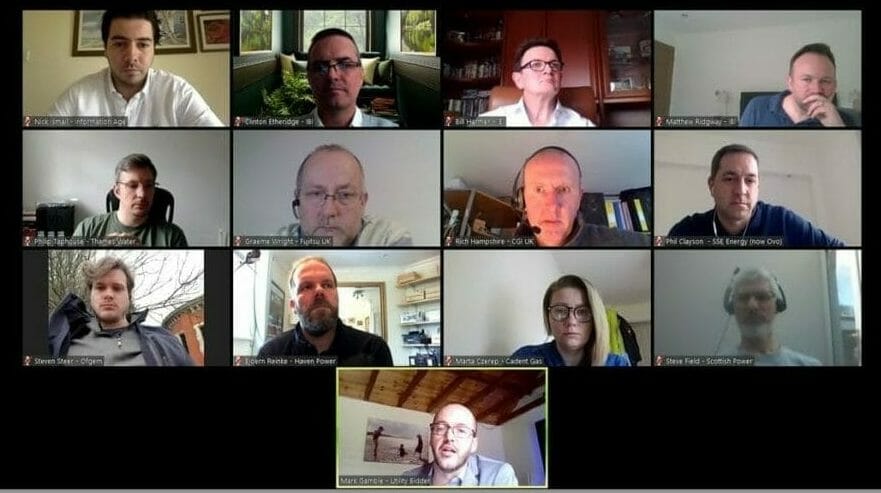What was initially planned as a general discussion on how the utilities sector is harnessing and driving value from data, it ended up with the backdrop of the coronavirus pandemic providing additional talking points.
Due to this pandemic, the roundtable — entitled ‘Harnessing the power of data in the utilities sector’ — was conducted via video conference. Organised in partnership with Information Builders, the discussion featured the following spokespeople:
- Nicholas Ismail, moderator and content editor at Information Age
- Bill Harmer, senior vice-president EMEA at Information Builders
- Bjoern Reinke, director of data and data science at Drax Group, parent company of Haven Power and Opus Energy
- Marta Czerep, head of data at Cadent
- Graeme Wright, chief digital officer, manufacturing, utilities and services at Fujitsu UK
- Philip Clayson, chief information officer at SSE Energy (now part of Ovo)
- Philip Taphouse, ServiceNow ITOM enterprise architect at Thames Water
- Richard Hampshire, vice-president, future utilities at CGI UK
- Steve Field, IT lead, distribution system operation at ScottishPower Energy Networks
- Steven Steer, head of data at Ofgem
- Mark Gamble, head of operations at Utility Bidder
- Clinton Etheridge, senior system engineer at Information Builders
- Matthew Ridgway, account director at Information Builders
Adapting to the coronavirus pandemic
Although the requirement of employees needing to work from home was always going to feel unfamiliar to many, the utilities sector have developed and implemented plans to use digital to adapt with the times.
“I suspect we’re at the early stages of this,” said Steve Field, IT lead, distribution system operation at ScottishPower Energy Networks. “So we’re looking at how to create the information that is required to continue to operate our business as more people become unable to perform their normal roles.
“For example, we may be able to build together management dashboards that give visibility of where we’ve got people in isolation, where we’ve got people are off sick, where we’ve got all kinds of key points of congestion in terms of activity that we need to support on the network, and maybe where the coronavirus hotspots are generally in the public.”
ServiceNow has developed a free emergency response service, which constitutes a portal of apps for business continuity. This includes a monitoring platform, called Emergency Outreach, which can be used to keep an eye on the condition and location of employees.
“You can take core support staff that look after physical assets, business systems or applications that make up all those systems and services, and link those people to it,” explained Philip Taphouse, ServiceNow ITOM enterprise architect at Thames Water.
“Then, you can use it as a kind of skills metrics, and very quickly start to see where you’d be vulnerable.”
Bjoern Reinke, director of data and data science at Drax Group, parent company of Haven Power and Opus Energy, gave his view on the use of apps and data to monitor the welfare and productivity of employees, outlining Drax’s efforts to link data use to HR.
“The challenge that we had to overcome was to link real time data to HR guidelines and modelling, sickness policies, and the obligation to make that fair for everybody, whilst looking after vulnerable or long-term sick employees,” he said.
“Therefore for us, the link to the HR system was important; the HR system is now driving all coronavirus-related statuses, which means that we can track not only adherence to the isolation period, but also the recovery of team members across all departments.”
Phil Clayson, CIO at SSE Energy (now part of Ovo), cited enabling teams to work remotely has been an enormous challenge.
“We’ve got about 900 technology people working from five different outsource partners across three continents,” he explained, “and as the UK, India and Manilla went into lockdown, we had to rapidly enable home working, assuring the connectivity and security of both systems and people, as well putting in place the emotional and welfare support for people in their new operating mode.”
The smart meter market: a huge opportunity, now the tech is ready
Empowering employees
When it comes to data usage across the company, a major aspect to be considered is the trust that is placed in employees.
For Graeme Wright, chief digital officer, manufacturing, utilities and services at Fujitsu UK, “data is only trusted with certain people.
“Sometimes, it goes across organisational boundaries, because of the third-party suppliers that people are using, and I don’t know if people have really been really incentivised to exploit the value of that data.”
Wright went on to explain that the field force “need a different method of interacting to make sure that the data flows freely from them into the actual centre so we can actually analyse it and understand what’s going on”.
Steven Steer, head of data at Ofgem, also weighed in on this issue: “This is really central to the energy sector’s agenda over the last year or so. The Energy Data Task Force, an independent task force, published its findings in June, and one of the main findings was the presumption that data is open to all, not just within your own organisation.
“That doesn’t mean to say all data has to be open. It’s an explicit expectation that data is first triaged for privacy, security, commercial and public good interests, but what this is doing is placing the burden of evidence on the people who are holding the data to provide the explanation for why, on this occasion, it can’t be shared, or maybe why you have to do some kind of desensitisation of the information before it is shared. This is an important cultural change now taking place in the energy sector.”
Carbon neutral
As for Rich Hampshire, vice-president, future utilities at CGI UK, it’s important to think about means of gaining data moving forward as the utilities sector moves towards carbon neutrality.
“As we move towards a net zero energy system, and as the dynamics of the system change, particularly for electricity, there’s a question around what data sources will be required in order to keep the system operating reliably and safely in the future,” he said.

Harnessing the power of data
The final section of the utilities sector roundtable on harnessing data focused on getting the best out of data across the company for the benefit of employees and customers.
“From what I’m observing, reports will be issued to whoever asks for the insight,” said Marta Czerep, head of data at Cadent. “There is a need to change the culture within the organisation to make information more widely available and promote the attitude of sharing what we know within wider audience, being proud of our discoveries and appreciating that the knowledge from our reporting belong to all of us and can influence our ways of working.”
Reinke contributed by sharing how data is managed across the organisation at Drax.
“At Drax, three data categories are put in place: reporting, analysis and use in data science.
“Across those three categories, you have privacy and security obligations, which are governed by a central data governance group. That’s a group of stakeholders, including operational leaders from across the business.
“Anybody can ask for data; the availability of data is published, but the access to it is managed for both the reporting category and the analytics category, for each individual user. We always make sure we respect and protect any personal data that is being handled.
“We create user groups with different kinds of access, so the private data or secure data is managed by user group. When it comes to the strategic data, for example, the energy consumption forecast or trading content – then you have more secure reports and data science projects that are on lockdown.”
Additionally, Clinton Etheridge, senior system engineer at Information Builders, suggested a need to keep an eye on how the market is changing in the current climate in order to be prepared for a similar situation arising in the future.
“I think it’s probably going to be very interesting to do a bit of analysis to see how the energy demand on the network has changed or shifted over the last week or two, from business demand dropping and personal home use energy spiking, or moving upwards.
“If there’s a potential that we might have another spike during the winter to come, it would be valuable to be able to do that analysis on the existing energy network grid to see how the current crisis situation has changed the demand, so that energy providers may be more proactive.”
Accenture helps United Utilities deploy a workforce management solution
The value from data comes from specific use cases
Bill Harmer, senior vice-president EMEA at Information Builders, expressed belief that these gaps can be filled in terms of what customers need, by being more specific about how utilities companies use data.
“In this subject area, it’s very easy to be generic and talk about general data, manipulation and orientation,” he said.
“But actually, the detail really comes in when we start talking about the specific use cases and I’m very keen to understand, from our company perspective, what those use cases are that are really not functional or not delivering the value that people are looking for.”
It’s clear that data has the potential to set utilities companies up to continue prospering throughout the current pandemic and beyond. With some work on internal communications between the field force and other company personnel, as well as improved insights into the workforce and the customer base, this aim can come to fruition going forward.







